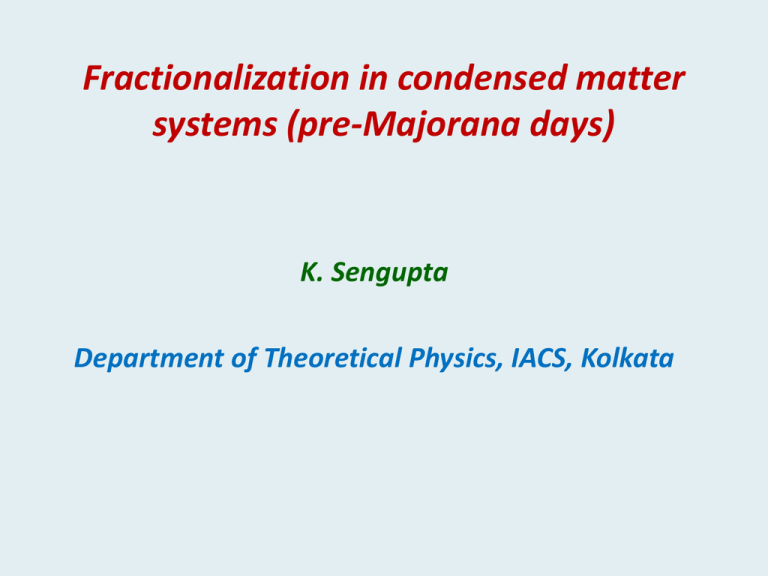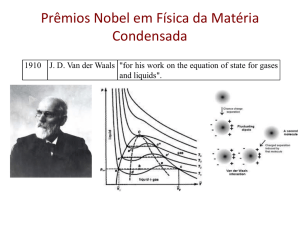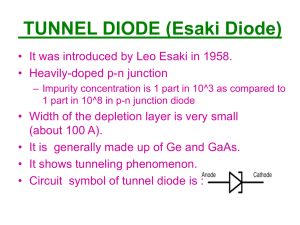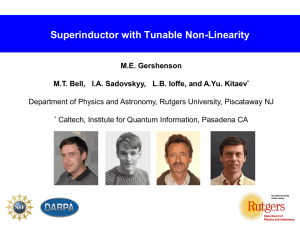Edge states and fractionalization in condensed matter systems
advertisement

Fractionalization in condensed matter systems (pre-Majorana days) K. Sengupta Department of Theoretical Physics, IACS, Kolkata Outline 1. Fermion number fractionalization in 1+1 D field theory 2. Finite sized system with fixed particle number 3. Edge states in p-wave superconductors: an exact solution 4. Experimental signature: tunneling conductance 5. Fractional Josephson effect: Theory and experiment 6. Conclusion Fractionalization in field theory Fermion number fractionalization in field theory R.Jackiw and C.Rebbi, Phys. Rev. D 13, 3398 (1976). 1+1 D coupled field theory of fermions and bosons Rajaraman, cond-mat/0103366 The bosonic sector in the absence of the fermions Vacuum sector solution: Soliton sector solution: The soliton sector solution or the kink can not spontaneously decay into the vacuum sector; kinks and anti-kinks can however annihilate each other Fate of Fermions: Vacuum sector The Lagrangian in the vacuum sector This leads to the standard Dirac equations in 1+1 D Usual construction of the Fermion Operator in terms of bk and dk A consequence of this constriction is that the number (charge) operator always has integer eigenvalues Q must be an integer. Note that all factors of ½ cancel due to the existence of paired energy modes Fate of Fermions: Soliton sector The Dirac equation now becomes Apart from the standard paired positive and negative energy solutions with energies Ek and –Ek, there is an unpaired localized zero energy mode which is its own charge conjugate The Fermionic operator now becomes There are two degenerate ground states related to the existence of the zero energy state These degenerate ground states are distinguished by their charge quantum number Number fractionalization Number operator now has fractional eigenvalues due to the presence of the bound states Two degenerate ground states have different eigenvalues of number operators. First example of Fermion number fractionalization arising from degeneracy. What happens in a real finite solid state sample with N electrons? Finite size version of the J-R solution Imagine that the 1+1D field theory is put in a finite size 2L with the periodic boundary condition It turns out that there are now two zero energy states at x=0 and L Localized at the origin Localized at one of the edges The Fermion field now becomes There are now four degenerate ground states which correspond to zero or unit filling of a or c quasiparticles There is no fractionalization of the total number: the theory is therefore compatible with integer number of electrons The effect of fractionalization can still be seen by local probes which will pick up signatures from one of the two states at zero energy. Key concept in understanding fractionalization in condensed matter systems Edge states in unconventional superconductors Pair Potential Mean-field potential due to pairing of electrons Center of Mass coordinate Variation around the Fermi surface Relative coordinate Direction of spin (for triplets only) Direction of spin (for triplet pairing) Global phase factor The edge problem Consider a semi-infinite sample occupying x>0 having an impenetrable edge at x=0 Upon reflection from such an edge, the BdG quasiparticles gets reflected from L To R on the Fermi surface The right and the left moving quasiparticles see opposite sign of the pair-potential The BdG wavefunction is superposition of the left and the right moving quasiparticles The boundary condition for the impenetrable edge Triplet Superonductivity in TMTSF The pair potential for triplet superconductivity is given by The BdG equation for the quasiparticles is given by Experimental inputs suggests that d is a real vector pointing along a; we choose our spin quantization along d leading to opposite spin-pairing. These are described by a 2 component matrix equation D is determined by the self-consistency condition in terms un and vn Exact solution 1. Extend the wavefunction from positive semispace to the full space using the mapping x>0 x<0 2. This leads to a single BdG equation defined for all x 3. The boundary condition of the edge problem translates to continuity of u and v at x = 0 4. For p-wave, D(x) changes sign at the origin and the problem is exactly mapped onto the 1D CDW problem solved by SSH and Brazovski (JETP 1980) 5. This allows us to write down the exact self-consistent solution for the edge problem Properties and spin response of the edge states The edge states carry zero net charge The edge states with momenta ky and –ky are identical They have half the number of modes and thus have fractional eigenvalues There is one Fermion state for each (ky,-ky) pair per spin In the presence of a Zeeman field, one generate a magnetic field of mB/2 per chain end. This is formally equivalent to having Sz=h/4 for these states. These states would be Majorana Fermions in 1D and for spinless (or spin-polarized) Fermions with equal-spin pairing ( Kitaev proposal) Experiments: How to look for edge states eV N-I-N interface Normal metal (N) Measurement of tunneling conductance Normal metal (N) Insulator (I) eV N-I-S interface Normal metal (N) Superconductor (S) Insulator (I) N I S Strongly suppressed if the insulating layer provides a large potential barrier: so called tunneling limit Basic mechanism of current flow in a N-I-S junction Andreev reflection 2e charge transfer In the tunneling limit, the tunneling conductance carries information about the density of quasiparticle states in a superconductor. Edges with no Midgap States Edges with Midgap States G(E=eV) G(E=eV) Typical tunneling conductance Curves Edge with midgap states. Edge without midgap states. Experiments for cuprates and TMTSF TMTSF Cuprates Covington et.al. 1997, Krupke and Deuscher 1999 ……… Naughton et al., unpublished mev Data from Cucolo et al, 2000. Tunneling in a-b plane in YBCO Unpublished data from Naughton et.al Signature of edge states in Josephson effect Josephson Effect S1 S2 The ground state wavefunctions have different phases for S1 and S2 Thus one might expect a current between them: DC Josephson Effect Experiments: Josephson junctions [Likharev, RMP 1979] S1 N S-N-S junctions or weak links S2 S1 B S2 S-B-S or tunnel junctions Josephson effect in conventional tunnel junctions S1 B S2 Formation of localized subgap Andreev bound states at the barrier with energy dispersion which depends on the phase difference of the superconductors. The primary contribution to Josephson current comes from these bound states. Kulik-Omelyanchuk limit: Ambegaokar-Baratoff limit: Both Ic and IcRN monotonically decrease as we go from KO to AB limit. Andreev bound states in Josephson junctions Consider two p-wave superconductors Separated by a barrier modeled by a local potential of strength U0 forming a Josephson tunnel unction L B R b= R,L and s denotes spin The superconductors acquire a phase difference f across the junction Solve the BdG equation across the junction with the boundary condition and find the subgap localized Andreev bound states Solution for the Andreev states On each side try a solution which is a superposition of right and left moving quasiparticles (index a denotes + or – for right or left movers) with momenta close to kF Substitute expressions for v and u in the boundary condition and demand non-zero solutions for Ab and Bb Leads to 4p periodic Josephson Current for p-p junctions Fractional AC Josephson effect Tunneling Hamiltonian approach Consider two uncoupled 1D superconductors (corresponds to D=0) with two midgap states for each transverse momenta Thus the projection of the electron operator on the midgap state is given by Now consider turning on a tunneling Hamiltonian between the left and the right superconductor A little bit of algebra yields the Effective tunneling Hamiltonian For the subgap states The tunneling matrix elements vanish at f=p where the states cross Recent experiments on doubling of Shapiro steps Recent experiments in 1D Semconductor wires with proximity induced superconductivity Doubling of first Shapiro step from hn/2e to hn/e for B > 2 T. Rokhinson et al Nat. Phys (2012)











